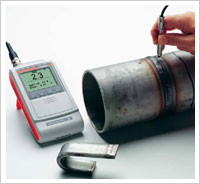ARL used State of the art FERITSCOPE FMP 30 and provides it in FN or in percentage (%) of Ferrite (Example 13.8% Ferrite FN = 16).
Ferrite test is done for Stainless Steel piping and vessel welds. For new pipelines weld joints intended to handle highly corrosive fluids, Ferrite test is normally done at three locations that is root pass, intermediate and on capping in order to have a stringent control over welding and to have a uniform and acceptable ferrite content in the weld joints. There are many variables which may change the ferrite content like welding technique, heat input etc.; same welding filler wire used by different welders, different techniques. Current input may result in different Ferrite number.
Ferrite test is normally done on those piping or vessels weld joints for which process licenser mentions it as mandatory mainly due to handling of highly corrosive fluids. If some part of a SS vessel has been repaired and it has to handle highly corrosive fluid like ammonium carbonate solution or urea, it is good to conduct a Ferrite test. Ferrite test authenticates that the final structure of the repaired area is authentic having greater resistance against corrosion.

